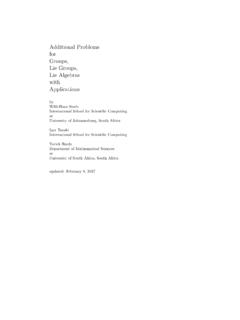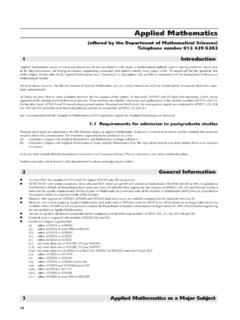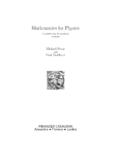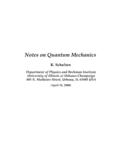Transcription of Problems and Solutions for Ordinary Di ferential Equations
1 Problems and SolutionsforOrdinary Diffferential EquationsbyWilli-Hans SteebInternational School for Scientific ComputingatUniversity of Johannesburg, South AfricaandbyYorick HardyDepartment of Mathematical SciencesatUniversity of South Africa, South Africaupdated: February 8, 2017 PrefaceThe purpose of this book is to supply a collection of Problems for ordinarydifferential books for ) Continous Symmetries, Lie Algebras, Differential Equations and Com-puter Algebra, second editionby Willi-Hans SteebWorld Scientific Publishing, Singapore 2007 ISBN 981-256-916-2 ) Problems and Solutions in Theoretical and Mathematical Physics, thirdedition, Volume I: Introductory Levelby Willi-Hans SteebWorld Scientific, Singapore, 2009 ISBN-13 978-981-4282-14-7 ) Problems and Solutions in Theoretical and Mathematical Physics, thirdedition, Volume II: Advanced Levelby Willi-Hans SteebWorld Scientific, Singapore, 2009 ISBN-13 978-981-4282-16-1 International School for Scientific Computing (ISSC) provides certifi-cate courses for this subject.
2 Please contact the author if you want to dothis course or other courses of the addresses of the page of the author: First Order Differential Equations12 Second Order Differential Equations223 First Order Autonomous Systems in the Plane484 Higher Order Differential Equations675 Elliptic Functions and Differential Equations1146 Nonautonomous Systems1237 Hamilton Systems126 Bibliography163 Index164viiChapter 1 First Order DifferentialEquationsWe consider differential Equations of the formdudt=f(u).(1)wheref:R Ris a continuous differentiable pointu is called afixed pointof the differential equation iff(u ) = equationofdu/dt=f(u) is given bydydt=(dfdu(u(t)))y(2)where it is assumed thatfis continuous 1.(i) Solve the initial value problemu(t= 0) = 0 for the firstorder Ordinary differential equationdudt=k(a u)(b u)wherek >0,a >0 andb >0.
3 (ii) Find the fixed points.(iii) What happens fort ?12 Problems and SolutionsProblem the qualitative behaviour of the one-dimensionalnonlinear differential equationdudt=r u2dudt=ru u2dudt= (1 +r2)u2whereris a bifurcation parameter. Study the behaviour of the fixed the solution of the initial value problem the lineardifferential equationdudx=x+u, u(0) = the nonlinear differential equationdudt= sin(u)with the initial valueu(t= 0) =u0= /2.(i) Find the fixed points.(ii) Solve the differential equation by direct integration. Hint. dusin(cu)=1cln(tan(cu2)).What happens ift ?(iii) Find the solution of the initial value problem using theLie seriesexpansionu(t) = exp(tsin(u)ddu)u u= the initial value problem of the nonlinear differen-tial equationdudt=u u2, u(t= 0) =u0>0.
4 (i) Solve the differential equation by direct integration. Findu(t) fort .(ii) Solve the differential equation using the Lie seriesu(t) =etVu u u0 First Order Differential Equations3whereVis thevector fieldVassociated with the differential equationV= (u u2) thelogistic equationdudt=ru(1 u)withu(t= 0) =u0. Find the solution of the initial value theBernoulli equationdudx+P(x)u=Q(x)un, n6= 0,1.(1) problem Ordinary differential equationH(t,u(t),dudt)= 0(1)may often be simplified or reduced to a standard form by introducing newvariables,T,Uby means of the equationsT(t) =G(t,u(t)), U(T(t)) =F(t,u(t)).(2)We assume thatH(t,u, u),G(t,u) andF(t,u) are smooth functions. Allconsiderations are local. Geometrically, we regard (2) as apoint transfor-mation, for it transforms points (t,u) of thetu-plane to points (T,U) oftheTU-plane.
5 We assume that theJacobian determinantJ:= (T,U) (t,u)= G t G u F t F u 6= 0(3)over a regionRof thetu-plane. There is then no functional relation betweenuandU; for this would implyJ= 0. Moreover, if the point (T1,U1)corresponds to (t1,u1) we can solve Equations (2) uniquely fort,uin theneighbourhood oft1,u1. We thus obtain the inverse transformationt(T) =Q(T,U(T)), u(t(T)) =P(T,U(T)).(4)Thus we can transform (1) into another H(T,U(T),dUdT)= 0.(5)4 Problems and SolutionsIf (5) can be integrated to give (T,U(T),C) = 0(6)we obtain a solution of (1) on replacinguandvby their values (2) in termsoftandu. Show thatdUdT= F ududt+ F t G ududt+ G t.(7) problem theBernoulli equationdudx+u=u3.(1) problem theBernoulli equationdudx+utanx=u3sec4x(1)where secx:= 1 theRiccati equationdudx e xu2 u ex= 0.
6 (1) problem the solution of the initial value problem of the specialRiccati equationdudt=u2+t, u(0) = 1.(1) problem the following. If in thegeneralized Riccati equationdudx=f(x)u2+g(x)u+h(x)(1)the coefficientsf,gandh, defined and continuous in some open interval(a,b) R, are related asf+g+h=ddxln ( f h)(2)with (x) and (x) properly chosen functions differentiable in (a,b) suchthat >0, then (1) is integrable by Order Differential Equations5 problem the initial value problem for theRiccati equationdudx=x2+u+ , u(0) = 0.(1)There is no elementary solution. Therefore one neglects the quadratic termand solves the linear equationdu1dx=x2+u1, u1(0) = 0.(2)(i) Show that this gives a first approximate solutionu1(x) = 2ex (x2+ 2x+ 2).(3)(ii) Reintroduce this solution into (1) and now solve the differential equationdu2dx=x2+u2+ (u1(x))2, u2(0) = 0.
7 (4)(iii) Show thatu2(x) =u1(x)+25e2x 215ex(x3+3x2+6x 54) 110(x4+8x3+32x2+72x+76).(5) problem s differential equationof the first kind is written inthe formdudt=a0(t) +a1(t)u+a2(t)u2+a3(t)u3(1)whereaj(j= 0,1,2,3) are known smooth functions oft. (i) Show that (1)can be put into the standard form asdzdx=z3+p(t)(2)by introducing the following transformationsu(t) =a(t)z(x(t)) +b(t), x(t) = ta2(s)a3(s)ds(3)witha(t) := exp( t(a1(s) a22(s)3a3(s))ds), b(t) =a2(t)3a3(t).(4)Herep(t) in (2) has the formp(t) =(a0 13a1a2a3+227a32a23+13ddta2a3)(a3a3) 1.(5)6 Problems and Solutions (ii) Show that ifa3= 0, (1) reduces to the Ricatti equation.(iii) Show that fora0= 0,a16= 0 and eithera2= 0, a36= 0 ora26= 0,a3= 0, it becomes the nonlinear differential equation of Bernoulli type,which has an explicit general that the homogeneous equationdudx+f(ux)= 0(1)is transformed byy=x, v(y(x)) =u(x)x(2)into the separable equationv+ydvdy+f(v) = 0.
8 (3) problem that the differential equationdudx=f(ax+bu+c x+ u+ )(1)can be integrated by means of apoint + 3u 44x+u 3.(1) problem the initial value problem of the differential equationdudt=k(a u)(b u), a > b >0(1)by direct integration ifu(t= 0) = 20.(i) Find the fixed points of the differential equationdudt=u u2.(1)(ii) Find the solution of (1) with the initial conditionu(t= 0) =u0.(iii) Find the variational equation.(iv) Study the stability of the fixed Order Differential Equations7 problem the nonlinear Ordinary differential equationdudt= qu1+(1/q), t >0(1)withu(0) = 1, whereqis any positive integer.(i) Show that using (1) recursively, we obtaindnudtn= ( 1)nq(q+ 1) (q+n 1)u1+n/q, n= 1,2, .(3)(ii) Show that theTaylor series expansionofuis then given byu(t) = 1 qt+ +( 1)nn!q(q+ 1) (q+n 1)tn+.
9 (4)(iii) Show that from the Cauchy-Hadamard theorem it follows that theradius of convergence of series (4) is 1. Show that the solution of the initialvalue problem is given byu(t) = (1 +t) q.(5)Thus,t= 1 is not a singular point ofuand the solution of the problem isdefined for anyt >0. But Taylor series (4) in its original form does notgive any informations aboutufort >1. (iv) ApplyPad e approximationto(4), and show that the [N/N+L] (L 0) approximant to it is given by[N/N+L] =1 +a1t+ +aNtN1 +b1t+ +bN+LtN+L(6)wheream=N(N 1) (N m+ 1)(N+L q)(N+L 1 q) (N+L m+ 1 q)m!(2N+L)(2N+L 1) (2N+L m+ 1)(7)withm= 1,2, ,Nandbm=(N+L)(N+L 1) (N+L m+ 1)(N+q)(N+q 1) (N+q m+ 1)m!(2N+L)(2N+L 1) (2N+L m+ 1)(8)withm= 1,2, ,N+L. Show that the [N/N+L] approximants forN+L qin a form of irreducible rational fractions reduce to the exactsolution (5).
10 problem to solve the classicalbrachystochrone problem (dudt)2=Lu 1oru(dudt)2+u=L(1)8 Problems and Solutionsby a series solution. We supposeh= 0 and the initial valueu(0) = the nonlinear differential equationdudt= u2(1)with the initial conditionu(t= 0) u0= 1 andt [0, ).(i) Show that the exact solution of the initial value problem is given byu(t) =11 +t.(2)(ii) Solve initial value problem of the differential equation (1) with the helpofLie the solution of the differential equationdudt=r u2, u(0) = 0(1)as a function of the bifurcation parameterr, wherer >0,r= 0 andr < the behaviour of the differential equationdudt=ru+u3(1)as a function of the bifurcation the behaviour of the differential equationdudt= u2, u(0) = 0(1)as a function of the bifurcation parameter , where >0, = 0 and < a functionu(x) (theinverse error function)x=2 u0exp( t2)dt(1)and show that it satisfies the differential equationdudx= 2exp(u2), u(0) = 0.]










